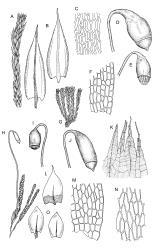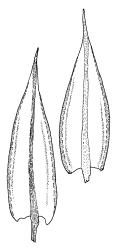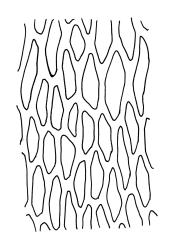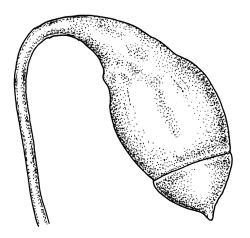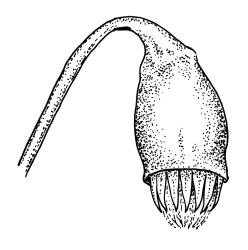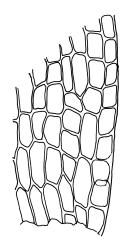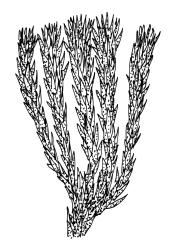- = Bryum buchananii R.Br.bis, Trans. & Proc. New Zealand Inst. 31: 450 (1899)
Plants brown- or olive-green, lustrous, forming loose turves on soil. Stems not visible through leaves, dark brown, 5–25 mm (rarely more), sparsely branched by innovation, beset with dark brown, very coarsely papillose rhizoids, in cross-section with firm-walled cortical cells and a distinct central strand. Leaves evenly spaced on stem, erect and imbricate when moist, only slightly more erect when dry, ovate-lanceolate, acuminate, with a single, weak plication on one or both sides of the leaf, 1.6–2.1 × 0.45–0.55 mm and with lamina 0.8–0.9 the total leaf length, moderately concave, ± olive-green throughout, entire, weakly bordered, not decurrent, and with margins strongly but narrowly revolute from base nearly to apex; upper laminal cells rhomboid-hexagonal, thick-walled, mostly 18–30 × 7–10 µm and 2–4:1, becoming more oblong but similar in size in lower leaf; marginal cells longer than adjacent cells to form a weak border at mid leaf, with a large but ill-defined group of ± quadrate cells near the lower margin; basal cells not differentiated, weakly brown- or rarely ± red-pigmented. Costa brown throughout or rarely red below, often with an adherent "tail" of cortical cells when removed from the stem, long-excurrent to form a concolourous awn. Brood bodies (including tubers) absent.
Dioicous. Perichaetia appearing lateral due to innovation; perichaetial leaves not differentiated. Perigonia on short (c. 1 mm) lateral branches, the inner bracts c. 1 mm, enclosing numerous antheridia and filiform paraphyses. Setae 15–25 mm, red, cygneous just below capsule; capsules pendent, broadly obovoid, c. 2 × 1.0–1.2 mm, dark red-brown, with a wrinkled neck c. ⅓ the total length; operculum mammillate, bluntly apiculate, dark red at maturity. Exostome teeth yellow-brown, connate at base; endostome with broad, widely-perforate segments ± equal the teeth, and 3 well-developed, appendiculate cilia. Spores 8–10 µm, smooth.
Sainsbury 1955, pl. 40, fig. 2; Ochi 1970, fig. 21 (as B. australe); Eddy 1996, fig. 419 (as B. australe); Spence & Ramsay 2006, fig. 43, i–o (as Gemmabryum australe).
Bryum appressifolium is sometimes confused with B. caespiticium. Bryum caespiticium has generally shorter stems (usually <5 mm), more elongate setae (commonly c. 40 mm), longer capsules (to c. 3.5 mm), and rhizoids that are more red-brown (compared to dark, ± chocolate brown) and less coarsely papillose than B. appressifolium. Its leaves also lack plications, are more narrowly recurved at their margins, lack a group of ± quadrate cells near the lower margin, have longer (to c. 60 µm) lower laminal cells, and red lower costae.
Confusion occasionally occurs between B. appressifolium and B. dichotomum. The latter is a less lustrous plant with nearly plane leaf margins and no plications; it normally produces axillary propagula, has red-brown rhizoids, larger (15–18 µm) spores, and nodose cilia.
The distinction between B. appressifolium and B. crassum is discussed under the latter species.
NI: N Auckland (Woodhill), S Auckland (Horahora, Waimangu Valley), Gisborne (Lake Waikaremoana, Hopuruahine River, Mt Maungapōhatu, Ruakituri River), Wellington (Okupata Caves); SI: Nelson, Marlborough (Hāpuku River), Canterbury, Westland, Otago, Southland (Longwood Range, Eyre Range, Waiau River); St.
Australasian? The extra-N.Z. distribution of this species is poorly documented. It was reported from Australia and Tasmania by Ochi (1970, as B. australe) and from New Guinea by Eddy (1996, p. 131, as B. australe). Spence & Ramsay (2006, as Gemmabryum australe) recorded it as rare from Australia, including Tasmania and also from South America. Records from Tasmania are particularly doubtful and are discussed below.
On sand or silt in open river beds or over rock, often locally abundant and sometimes forming turves of several square metres. Also on glacial detritus, and generally in insolated and disturbed sites. Occurring in areas of various bedrock including limestone, schist, and greywacke. Ceratodon purpureus, Breutelia pendula, various Bryum spp., Tridontium tasmanicum, and Racomitrium crispulum s.l. are frequent associates. Occurring from near sea level to at least 830 m (and probably to 1000 m or more). Bryum appressifolium is a widespread and common species on the South I. The North I. distribution appears to be more localised and about half the collections from that island are from near Lake Waikaremoana.
The olive- or brown-green plants with elongate stems and densely spaced, erect-imbricate leaves with strongly recurved margins make B. appressifolium one of the most recognisable of N.Z. Bryum spp. The presence of a single rather weak plication on one or both sides of the leaf, mostly clearly visible when leaves are removed from the stem, facilitates recognition. The costae and basal leaf cells of B. appressifolium usually lack red pigmentation, but such pigmentation is present in a minority of populations. The dark red operculum is large in relation to the capsule.
Collections from the Godley Valley, Mt Cook N.P., Canterbury L.D. (CHR 241102) have more elongate stems (to c. 50 mm) and more slender and shorter (c. 1.5 mm) leaves than usual for the species. This material was probably collected from a wet habitat.
The Bell collection from Mt Alfred is selected from several syntypes (in H-Brotherus) as the most appropriate lectotype of B. appressifolium because it is, in addition to conforming with the protologue, representative of the species, amply fruiting, represented by an isolectotype in CHR, and bears some habitat information.
Ochi's (1970, p. 38) placement of B. appressifolium as a synonym of B. australe Hampe is not accepted; the type of B. australe (Preiss, Swan River, Western Australia, BM!) is a different species. Bryum australe differs from B. appressifolium by its non-imbricate leaves that do not obscure the stems, denticulate leaf margins, a stouter costa, and the absence of leaf plications.
Records of the present species in Tasmania are particularly doubtful. A duplicate of the single Tasmanian specimen that Ochi (1970) cited from there (as B. australe; Weymouth 838, CHR 630889) has been determined as B. caespiticium. Dalton et al. (1991) also excluded this species from the Tasmanian flora.




